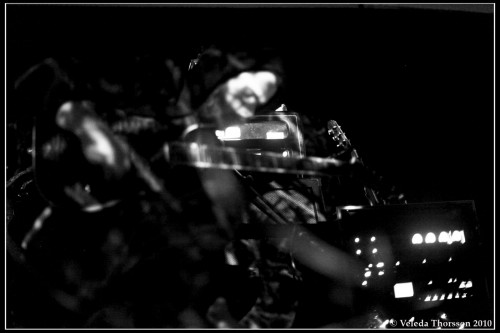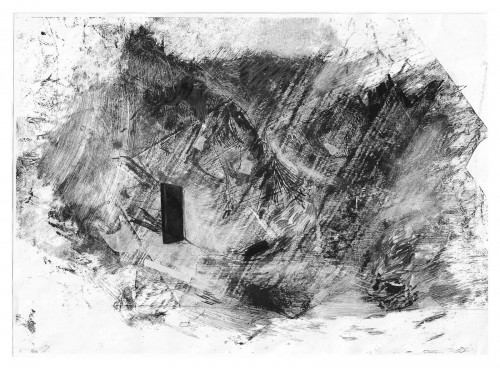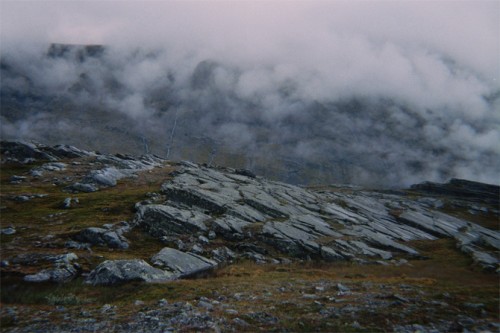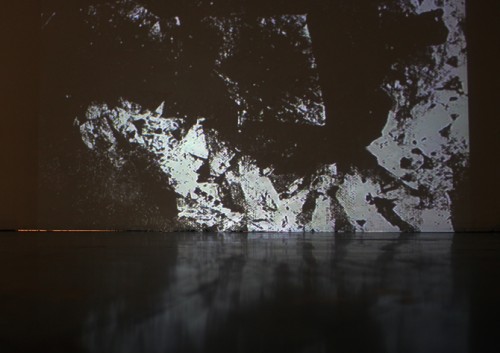Niels Geybels is a visual artist, graphic designer, and musician based in Antwerp, Belgium. I was introduced to his work last year through Zeitgeists Publishing, an independent publisher of art and music editions. (They also work with Terence Hannum, who I featured in an earlier interview). As a musician, Geybels establishes a distinctive keynote by layering long, deep, and spanning tones. He builds complex textures using a variety of internal dynamics such as rhythm, phasing, harmonics, and dissonances. This description could also be applied to his visual art, which includes painting, printmaking, photography, artists’ books, and video. His artworks are often about tone or atmosphere. Photographs of the Swedish mountains appear throughout Geybels website; it is as though he has redirected his impressions of them into guitar effects and xerography. In each, there is a sense of fog and the smear of dense clouds rolling above, the rhythm of grass blades in the distance, and the hard surface of rock breaking through a surface and jutting into the air. In this interview, Geybels and I talk about his project Sequences, his 2011 zine Monoliths, and his forthcoming project Beneath the Earth. (In thinking about the Transmission column as a whole, I am considering here how Geybels’s work resonates aesthetically and conceptually with the work of Faith Coloccia, who was featured in this column last year.)
Amelia Ishmael: Let’s start by talking about Sequences. Can you give me a few examples of what it is? What are some of the ideas or questions that you are exploring with this project?
Niels Geybels: Well, since it’s exclusively my vision, which has also been growing, shifting and developing tremendously through the years, it’s always difficult to explain what Sequences is exactly. Since the beginning it has been dealing with themes such as life and death–themes that are universal and very personal at the same time. Sequences is also very closely connected to nature, and [the idea of] returning back to it. Obviously, there’s much more going on. But it is the task of the viewer/listener to perceive those concepts through the music, artwork, titles, etc. One could also say that Sequences merely exists as an exploration of textures and the creation of both audial and visual counterparts simultaneously.
AI: Is Sequences a solo project then? Do you use this name to describe both the music and visual art?
NG: Sequences is an audio-visual experiment and project. It’s a completely solo endeavor, although I love to collaborate with other artists. So yes, Sequences is much more than music; it also has its visual counterpart. Both are equally important. To avoid any misunderstandings, not all the visual art I create is done under the Sequences moniker. I also create art and design for other artists and bands, as well as art pieces, paintings, and collages that do not have anything to do with Sequences.
AI: When did the Sequences project start? Did it start as a visual or sonic project and then merge, or was there always a cross-disciplinary aspect?
NG: Sequences started around August/September 2008, when I started to experiment with music and sound for the first time. I’m a completely self-taught musician and I only knew the guitar as an instrument before that period. I started recording things which were unusual for me at that time: field recordings of rain and wind, and also more defined sources of sound such as breaking glass and slamming doors. In combination with these recordings, I started to search for ways that I could use my guitar to create sound without playing notes and chords. These first recordings resulted in Vespertine: A Tragedy in Several Tones of Grey, which was released in November 2009. I think that album shows what I was capable of at that particular time. I felt very limited in what I was able to do and some of my ideas were somewhat too ambitious. The additional recordings by Jeffrey Neblock (from Vindensång) definitely lifted the whole album in an higher direction.
Sequences started as an outlet for my musical experiments, but it quickly became clear, after those first attempts, that the visual direction of the project was as important as the music. Both disciplines support each other…They became inseparable, at least for me.
AI: Can you tell me about this image [above] from the Monolith project? Was it originally a print or a drawing? What is going on in this image?
NG: That image represents a monolith, a black and abstract volume amidst an uncontrolled, barren landscape. It’s created with a very mixed technique. I’ve used monotype, ink, paint and collage. This gives good insight into how I work. I use a variety of techniques and, mostly, it’s very intuitive. As with this image, it also very often happens that I have more than one end result. The only matter of choice is which image works best.
AI: Landscape and atmosphere are interests that seem pretty consistent in your sound as well as visual work. Can you tell me about the atmosphere where you live now and how it compares to what you desire in the images and sounds you create? Are you accentuating a characteristic of that atmosphere or creating a different space altogether?
NG: The place where I live and grew up isn’t connected to the landscape that fascinates me and that I envision in my artwork and music. If there’s any connectivity at all then it would be that the environments where I live now and grew up are the opposite of each other. I’ve been fascinated by wide and dense landscapes as long as I can remember. Everything I experience, I perceive very visually. This might explain why nature and landscapes are so prominent in my work. I’ve never pursued the display of an actual, existing place on earth. I mainly work with concepts and abstract ideas… The conceived sceneries might reflect certain personal states of mind but that has never been the main objective.
AI: You mentioned earlier that you are currently working on a large project. What will this be? From the recent posts to your website [such as the one above] it looks like it might include projected video images as well as a musical performance. Will this be like an immersive Sequences exhibition?
NG: Yes. The project is called Beneath the Earth and it will result in the new Sequences album. I’ve been working on it for quite some time now, and I’m relieved to say that it’s nearing it’s completion. It’s built around the themes of death, dying, and the possibility of reincarnation in whatever form—complete nothingness or a new entity. I’ve done a lot of research on this matter and also on how to represent both audio and visuals, combined, in an intricate way without the loss of a clear vision. Once the whole project is finished, I hope to do an exhibition with both projected images, a publication, and a live performance.
AI: An installation, publication, and performance. This is quite an ambitious project! I look forward to hearing more details! The exhibition will be a record release also? Is this the first time that you will create a completely immerse experience?
NG: Quite ambitious indeed, and that’s possibly why it feels like it’s never coming to an end. It’s the goal to have copies of the album in different formats for sale at that particular time. I think it will come close to the complete immerse experience that I have in mind. I’ve done exhibitions and live shows before, but this should be the perfect setting.








